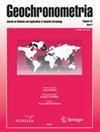Investigations on the Luminescence Properties of Quartz and Feldspars Extracted from Loess in the Canterbury Plains, New Zealand South Island
IF 0.9
4区 地球科学
Q3 Earth and Planetary Sciences
引用次数: 2
Abstract
Abstract The applicability of the single-aliquot regenerative-dose (SAR) protocol, by using the optically stimulated luminescence (OSL) signal of quartz as well as the post-infrared–infrared (pIRIR) signals of polymineral fine grains, namely pIRIR225 and pIRIR290, was assessed for dating loess in New Zealand South Island. OSL signals of quartz grains displayed low sensitivity. However, the application of repeated irradiation/bleaching cycles did not result in an increase in sensitivity; annealing in the 300–500°C temperature range generated the sensitisation of both the 110°C thermoluminescence (TL) peak as well as the OSL signal, likely by activation of yet unidentified luminescence centres. After heating, the quartz signal is comparable to that of ideal samples, but the annealing is precluding successful dating. On the other hand, feldspar infrared-stimulated signals displayed satisfactory properties, allowing estimation of ages ranging from 14 ± 1–29 ± 3 ka for the investigated deposit. It was shown that pIRIR225 and pIRIR290 methods have potential for dating loess in the South Island of New Zealand, based on the following observations: (i) Dose recovery tests were successful with recovered-to-given dose ratios with a <10% deviation from unity, (ii) constant residual values of about 4 Gy and about 10 Gy were obtained after exposures for 48 h in the case of pIRIR225 signals and 96 h in the case of pIRIR290 signals, respectively, (iii) while a slight dose-dependence of the residual was reported, and for a dose as large as 1600 Gy the residual values are ≅9 Gy and ≅19 Gy for pIRIR225 and pIRIR290 signals, respectively.新西兰南岛坎特伯雷平原黄土中石英和长石的发光特性研究
摘要通过使用石英的光激发光(OSL)信号以及多矿物细粒的后红外-红外(pRIR225和pRIR290)信号,评估了单等分再生剂量(SAR)方案在新西兰南岛黄土测年中的适用性。石英颗粒的OSL信号显示出低灵敏度。然而,重复照射/漂白循环的应用并没有导致灵敏度的增加;在300–500°C温度范围内的退火产生了110°C热释光(TL)峰值和OSL信号的敏化,可能是通过激活尚未确定的发光中心。加热后,石英信号与理想样品的信号相当,但退火阻碍了测年的成功。另一方面,长石红外激发信号显示出令人满意的特性,可以估计所研究矿床的年龄范围为14±1–29±3 ka。基于以下观察结果表明,pRIR225和pRIR290方法具有确定新西兰南岛黄土年代的潜力:(i)剂量回收试验是成功的,回收与给定剂量比的偏差小于10%,(ii)在pIRIR225信号的情况下,暴露48小时后分别获得约4 Gy和约10 Gy的恒定残差值,在pRIR290信号的情况中,暴露96小时后,分别获得约10 Gy.(iii)同时报告了残差的轻微剂量依赖性,并且对于高达1600 Gy的剂量,pRIR225和pRIR290%信号的残差值分别为?9 Gy和?19 Gy。
本文章由计算机程序翻译,如有差异,请以英文原文为准。
求助全文
约1分钟内获得全文
求助全文
来源期刊

Geochronometria
地学-地球科学综合
CiteScore
2.20
自引率
0.00%
发文量
1
审稿时长
>12 weeks
期刊介绍:
Geochronometria is aimed at integrating scientists developing different methods of absolute chronology and using them in different fields of earth and other natural sciences and archaeology. The methods in use are e.g. radiocarbon, stable isotopes, isotopes of natural decay series, optically stimulated luminescence, thermoluminescence, EPR/ESR, dendrochronology, varve chronology. The journal publishes papers that are devoted to developing the dating methods as well as studies concentrating on their applications in geology, palaeoclimatology, palaeobiology, palaeohydrology, geocgraphy and archaeology etc.
 求助内容:
求助内容: 应助结果提醒方式:
应助结果提醒方式:


